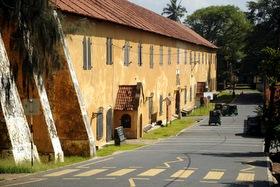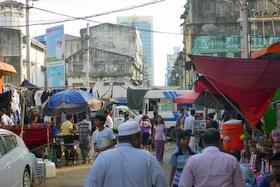
Dutch East India Company warehouse in Galle Fort, Sri Lanka. Cinnamon would have been stored on the upper level. Lori Beppu photo.

Youngster at work in Kuffus Adventure Playground along the Berlin Wall, where children design and build their own play sets out of donated construction materials. Chiara DiPalma photo.

Anawratha Road in downtown Yangon, a crowded ethnically and religiously diverse area. Billy Schaefer photo.
Enable top students to study local architecture style and influences, conduct research with aim toward incorporating ideas into future practice
How did the spice trade influence architecture on two continents? That question led Lori Beppu, a graduate architect student in The City College of New York’s Spitzer School of Architecture, to travel to Sri Lanka and the Netherlands last year to search for answers, supported by a $5,000 travel fellowship from the Spitzer School.
Ms. Beppu, who received her MArch degree in June 2012, was one of four members of the Spitzer School’s Class of 2012 to receive the stipends to visit such diverse cities as Amsterdam, Berlin, Colombo, Jakarta and Yangon. She, along with Chiara Di Palma, MA Landscape Architecture, ’12, and Billy Schaefer and Yoo Jin Lee, both BArch, 2012, will discuss their journeys in an event at the Spitzer School 6:30 p.m. Monday, February 4.
The four new graduates comprise the third cohort of Spitzer students to receive the travel grants, which were begun soon after CCNY’s architecture school was named for benefactors Bernard and Anne Spitzer in 2009. Mr. Spitzer, a prominent New York real estate developer and manager, is a 1943 CCNY engineering graduate. Previous recipients have visited Italy, Japan, Mexico and Turkey, noted Associate Professor of Architecture Marta Gutman, who runs the travel fellowship program.
“The travel awards not only enable students to experience different cultures, but also to develop their knowledge of how culture, history and environment influenced architecture and be able to incorporate that understanding and research skills into their practice,” Professor Gutman said. “Top design schools encourage their students to study abroad, and the Spitzer School at City College is no exception.”
Ms. Beppu’s dual interests in architecture and food inspired her project, which draws connections between the cultures of food and architecture. She chose to focus on Sri Lanka because it was for centuries the single point of origin for cinnamon sent to Europe. She examined how the cinnamon trade influenced Dutch architecture there because the Dutch were in control for longer than the Portuguese or British and they adapted to the climate rather than impose their style.
She spent two weeks there, getting the lay of the land and studying buildings from the Dutch colonial era in order to understand the Dutch architectural style and see how it influenced the local architecture. Then, she flew to Amsterdam “to get the rest of the picture,” namely the movement of ideas from Sri Lanka to the Netherlands and how that movement was influenced by the cinnamon trade.
“The cinnamon trade was highly profitable and it brought a lot of money into Amsterdam, which led to a lot of buildings being constructed,” the Southampton resident said. “The evidence of Sri Lankan influence is more subtle than I expected but it is definitely there. You might see it in the fabrics found in a wealthy person’s home having monkeys, peacocks and other symbols of the region.”
Ms. Di Palma’s journey took her to Berlin to study the resurgent and informal use and development of public space along the route of the Cold War-era Berlin Wall. “I had been to Berlin before and was impressed by the community’s commitment to public space, the various strategies people use to create it and how much they value it,” the Santa Fe native explained. “These are topics that really interest me because I want to focus on public spaces in my career.”
Unlike the United States, where design of public spaces relies on a top-down approach, in Berlin people use whatever they have, Ms. DiPalma noted. One example: adventure playgrounds, where children get donations of building materials, mainly wood and bricks, from construction companies and use them to build structures.
After the Berlin Wall was dismantled, the narrow strip of land behind it, once known as the Death Strip, became open terrain where community residents developed spaces on their own with little or no government involvement. Besides parks and adventure playgrounds, the Death Strip became home to nightclubs in abandoned factories and wagon villages; communities of minimalist homes occupied by squatters.
Now, the area is undergoing gentrification and condominiums are being developed along the Death Strip. “Berlin is at a tipping point, and all of these activities are endangered due to a surge of new residents,” said Ms. DiPalma, who found a job in the German capital and will participate in Monday’s event via Skype.
Changing urban environments in two bustling Asian cities were the impetus for a joint project by undergraduate architecture classmates Billy Schaefer and Yoo Jin Lee. They are exploring how the cities of Jakarta, Indonesia, and Yangon, Myanmar, have followed different development directions since publication of a 1949 volume that compared the two former colonial capitals.
Mr. Schaefer, whose mother comes from Myanmar, spent two weeks in Yangon in November. “I had always heard about what a great place (Yangon) was, but it was cut off from the rest of the world by a repressive government.” He admitted to some apprehension when he first arrived, but said he actually felt quite comfortable there.
A visit to the country by President Obama a few weeks earlier might have softened the ground for him, since people were excited about the President’s trip. Also, on his first night there, he met an English-speaking engineer who invited him to tour an old railway headquarters building that was undergoing restoration.
The opening of Myanmar to the outside world has thrust rapid change upon the country, especially Yangon, the largest city. “The speed at which things are happening is insane,” Mr. Schaefer said. “One guide pointed to a bank that had automated teller machines in shrink wrap. They were the first ATMs in the country. More things are happening in a week than happened in a year. I’m still trying to make sense of it all.”
“While Yangon is architecturally beautiful, it is mostly in a very run-down state,” he added. “Even downtown, the sidewalks are extensively cracked or nonexistent in some places, and there's no real street lighting. Walking around at night was comparable to New York during a blackout.”
His partner Yoo Jin Lee’s trip to Jakarta could help him do that. She leaves for Indonesia on Tuesday, and will spend two weeks there looking at sites of colonial architecture to see how developed or overdeveloped they became since the country gained its independence. After her return, she and Mr. Schaeffer will compare notes.
“Yangon is Asian’s newest boom town, and it is often compared to Jakarta,” she said. “My trip will be a critical look at the situation in Indonesia, what they did and did not do with their colonial architecture and what lessons it can offer for Yangon.”
The trip will also be a homecoming of sorts. Ms. Lee, who was born in South Korea, spent part of her childhood in Indonesia and last visited there six years ago. “I’ve been told that Jakarta went through a lot of development and change since I last visited,” she said. “The Indonesia I remember is probably very different from what it is today.”
On the Internet
MEDIA CONTACT
Ellis Simon
p: 212.650.6460
e:
esimon@ccny.cuny.edu